1995 CADILLAC ELDORADO air condition
[x] Cancel search: air conditionPage 183 of 395

Downloaded from www.Manualslib.com manuals search engine ST/PL Press this button to switch back to the radio without ejecting the
tape. Press
it a second time to start playing the tape again.
EJCE Press this button to remove the tape.
To Play a Compact Disc
Before you begin, please note: don’t use the mini-discs that are called “singles”
(even with an adapter). They won’t eject.
Use full-size compact discs only.
1. Turn the radio on.
2. Insert a CD (label side up) partway into the slot. The player will puil it
in. Wait a few seconds and the CD will play. Then only the time of day
and CD
will display.
If the CD comes back out, check to see if
The disc is upside down.
The disc is dirty, scratched or wet.
There’s too much moisture in the air. If there is, wait about one hour
and try it again.
ERR: This error message is displayed if you have a condition of either
extreme temperature, moisture
or an incorrect CD. The CD will
automatically be ejected. When conditions are back
to normal the CD
should play again.
RCWPROG: Press this recall/program button once to see what track is
being played. Within five seconds press
it a second time to see how long
the track has been playing. Press
it a third time to see the time of day.
REV: Press and hold the reverse button to return rapidly within a track.
Release it to play the passage. The elapsed time
will be displayed to show
the reverse progress of the CD.
FWD: Press and hold this forward button to advance rapidly within a
track. Release it
to resume playing. Elapsed time will be displayed to show
the forward progress
of the CD.
PRET Press this button to go back to the beginning of the track. Pressing
this button
when in the pause period between tracks will take it back to
the start
of the track preceding the pause.
NEXT: Press this button to advance to the next track.
3-18
Page 239 of 395
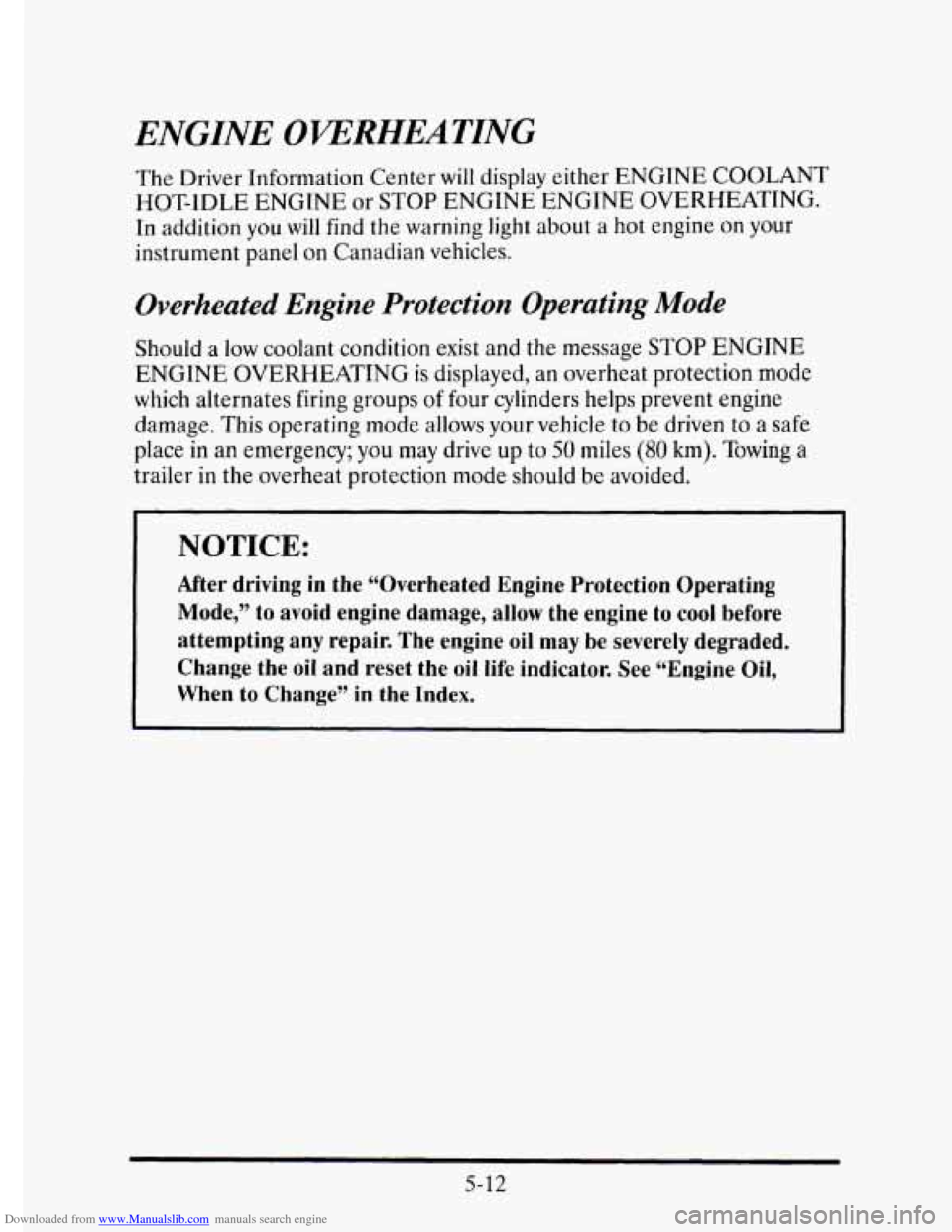
Downloaded from www.Manualslib.com manuals search engine ENGINE OKEMEATING
The Driver Information Center will display either ENGINE COOLANT
HOT-IDLE ENGINE or
STOP ENGINE ENGINE OVERHEATING.
In addition you will find the warning light about a hot engine on your
instrument panel on Canadian vehicles.
Overheated Engine Protection Operating Mode
Should a low coolant condition exist and the message STOP ENGINE
ENGINE OVERHEATING is displayed, an overheat protection mode
which alternates firing groups of four cylinders helps prevent engine
damage. This operating
mode allows your vehicle to be driven to a safe
place
in an emergency; you may drive up to 50 miles (80 km). Towing a
trailer in the overheat protection mode should be avoided.
NOTICE:
After driving in the “Overheated Engine Protection Operating
Mode,” to avoid engine damage, allow the engine
to cool before
attempting any repair. The engine oil may be severely degraded.
Change the oil and reset the
oil life indicator. See “Engine Oil,
When
to Change” in the Index.
5-12
Page 241 of 395
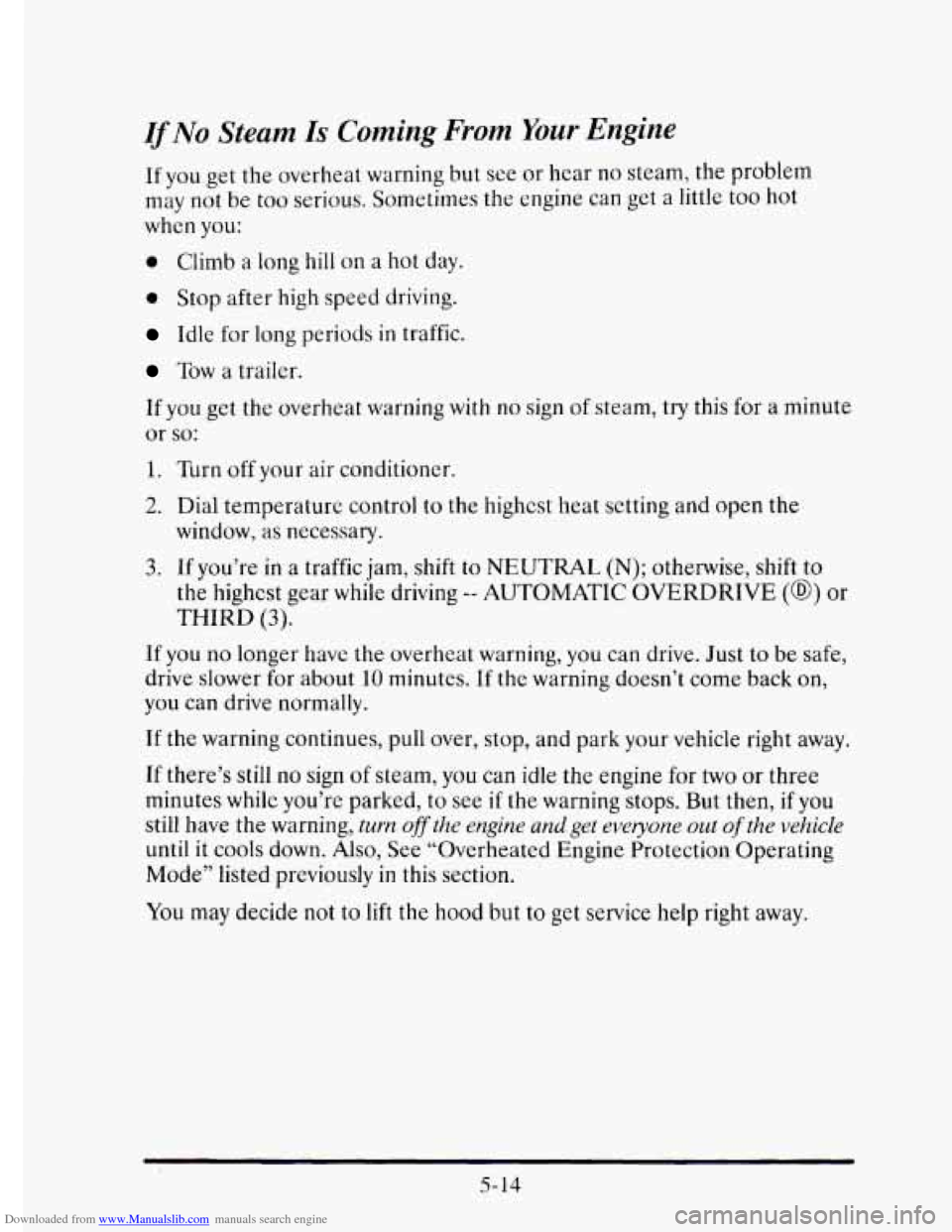
Downloaded from www.Manualslib.com manuals search engine If No Steam Is Coming From Your Engine
If you get the overheat warning but see or hear no steam, the problem
may not be
too serious. Sometimes the engine can get a little too hot
when you:
0 Climb a long hili on a hot day.
0 Stop after high speed driving.
Idle for long periods in traffic.
Tow a trailer.
If you get the overheat warning with no sign of steam,
try this for a minute
or
so:
1. Turn off your air conditioner.
2. Dial temperature control to the highest heat setting and open the
window,
as necessary.
3. If you’re in a traffic jam, shift to NEUTRAL (N); otherwise, shift to
the highest gear wh.ile driving
-- AUTOMATIC OVERDRIVE (@) or
THIRD (3).
If you no longer have the overheat warning, you can drive. Just to be safe,
drive slower for about
10 minutes. If the warning doesn’t come back on,
you
can drive normally.
If the warning continues,
pull over, stop, and park your vehicle right away.
If there’s
still no sign of steam, you can idle the engine for two or three
minutes while you’re parked,
to see if the warning stops. But then, if you
still have the warning, turn off the engine and get everyone out of the vehicle
until it cools down. Also, See “Overheated Engine Protection Operating
Mode’’ listed previously
in this section.
5-14
You may decide not to lift the hood but to get service help right away.
Page 291 of 395

Downloaded from www.Manualslib.com manuals search engine NOTICE:
Continuing to drive with worn-out brake pads could result in
costly brake repair.
Some driving conditions or climates may cause a brake squeal when the
brakes are first applied
or lightly applied. This does not mean something
is wrong
with your brakes.
Brake linings should always be replaced as complete axle sets.
Brake Pedal Travel
See your dealer if the brake pedal does not return to normal height, or if
there is a rapid increase in pedal travel. This could bc a sign of brake
trouble.
Brake Adjustment
Every time you apply the brakes, with or without the vehicle moving, your
brakes adjust for wear.
Replacing Brake System Parts
The braking system on a modern vehicle is complex. Its many parts have
to be
of top quality and work wcll together if the vehicle is to have really
good braking. Vehicles
we design and test have top-quality GM brake
parts in them,
as your Cadillac does when it is new. When you replace
parts of your braking system
-- for example, when your brake linings wear
down and
you have to have new ones put in -- be sure you get new
genuine
GM replacement parts. If you don’t, your brakes may no longer
work properly. For example,
if someone puts in brake linings that are
wrong for your vehicle,
the balance between your front and rear brakes
can change
-- for the worse. The braking performance you’ve come to
expect can change in many
other ways if someone puts in the wrong
replacement brake parts.
6-32
Page 308 of 395
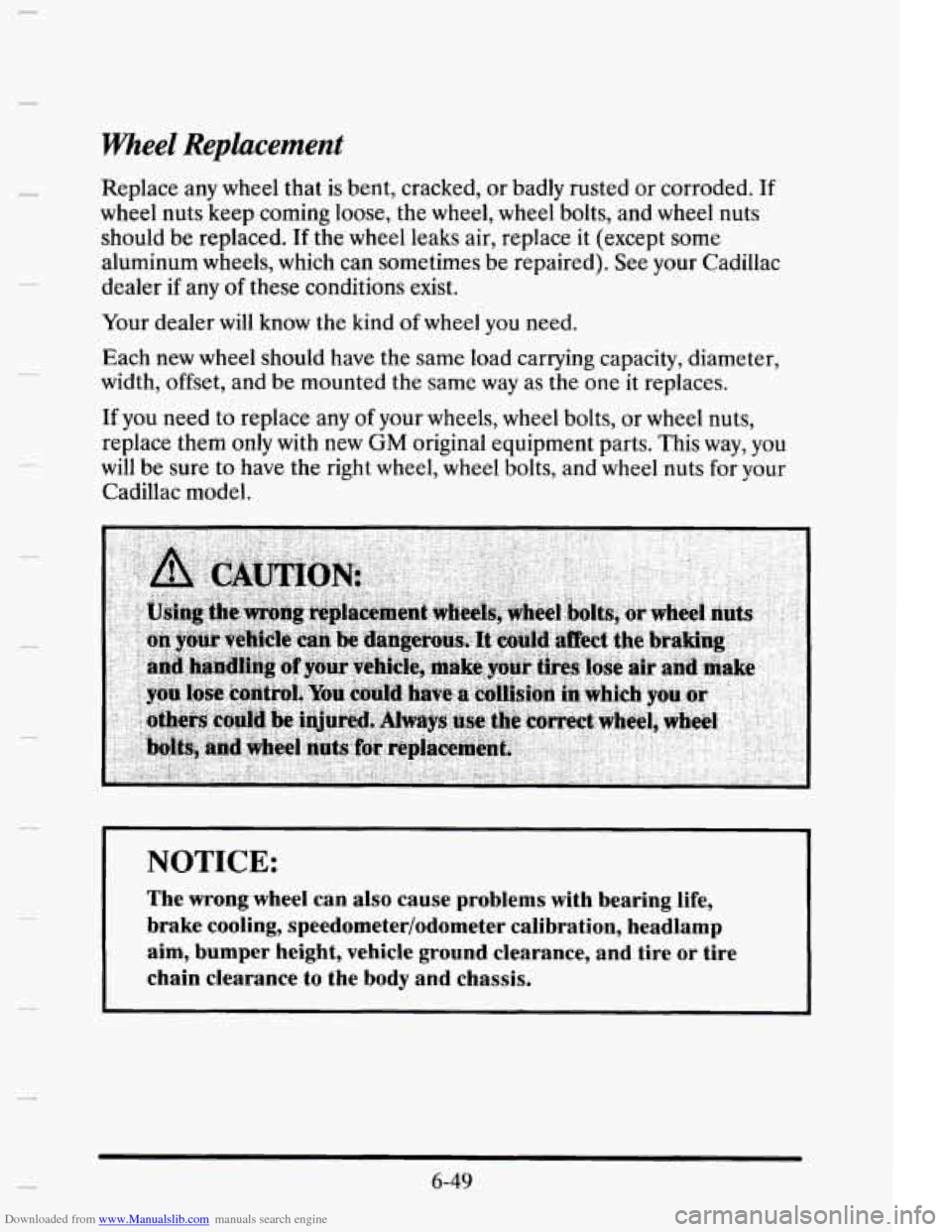
Downloaded from www.Manualslib.com manuals search engine Wheel Replacement
Replace any wheel that is bent, cracked, or badly rusted or corroded. If
wheel nuts keep coming loose, the wheel, wheel bolts, and wheel nuts
should be replaced. If the wheel leaks air, replace
it (except some
aluminum wheels, which can sometimes be repaired). See your Cadillac
dealer
if any of these conditions exist.
Your dealer will know the kind of wheel you need.
Each new
wheel should have the same load carrying capacity, diameter,
width,
offset, and be mounted the same way as the one it replaces.
If you need to replace any of your wheels, wheel bolts, or wheel nuts,
replace them
only with new GM original equipment parts. This way, you
will be sure to have the right wheel, wheel bolts, and wheel nuts for your
Cadillac model.
NOTICE:
The wrong wheel can also cause problems with bearing life,
brake cooling, speedometer/odometer calibration, headlamp aim, bumper height, vehicle ground clearance, and tire or tire \
chain clearance
to the body and chassis.
6-49
Page 318 of 395
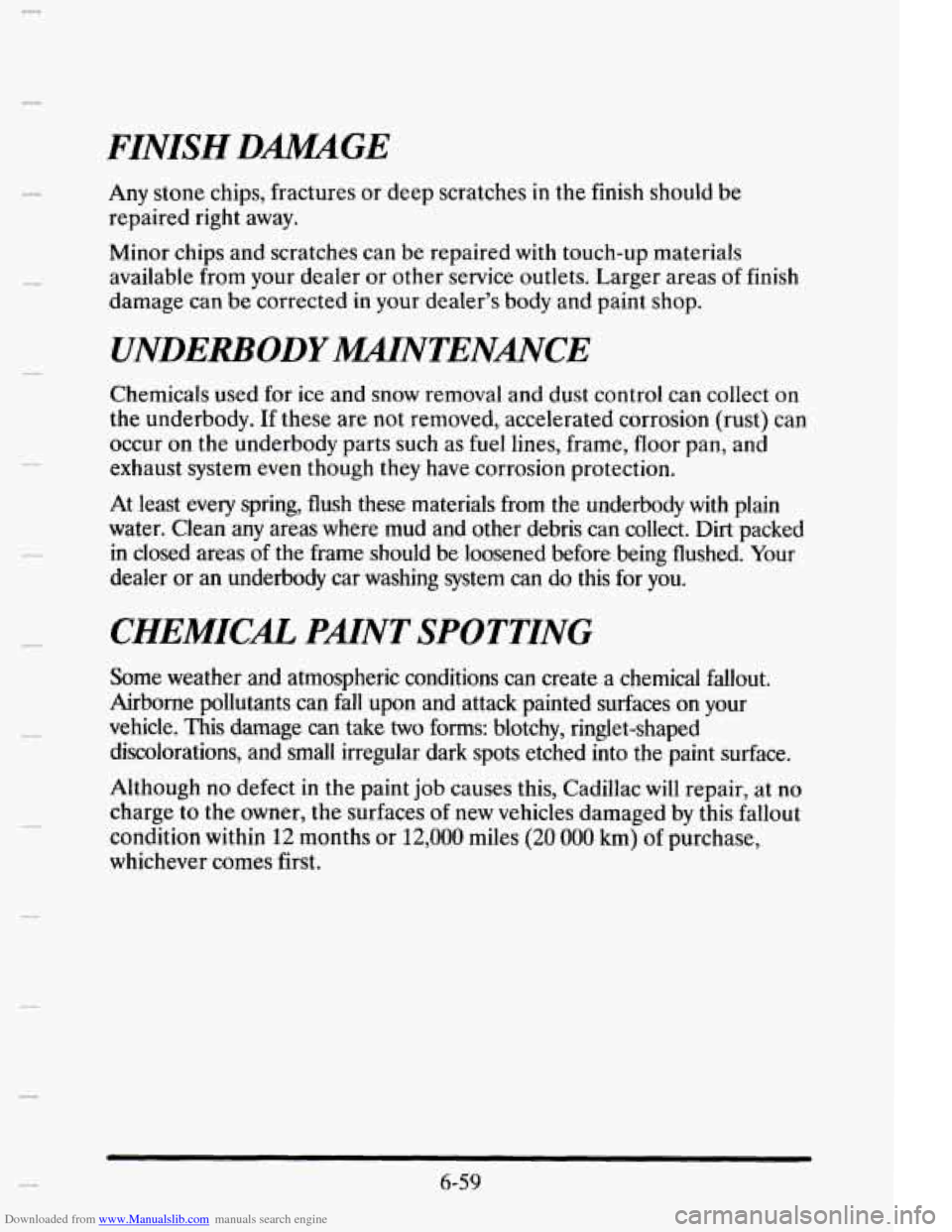
Downloaded from www.Manualslib.com manuals search engine FINISH DMGE
Any stone chips, fractures or deep scratches in the finish should be
repaired right away.
Minor chips and scratches can be repaired
with touch-up materials
available from your dealer or other service outlets. Larger areas
of finish
damage can be corrected
in your dealer’s body and paint shop.
UNDERBODYMNTENANCE
Chemicals used for ice and snow removal and dust control can collect on
the underbody. If these are not removed, accelerated corrosion (rust) can
occur on the underbody parts such
as fuel lines, frame, floor pan, and
exhaust system
even though they have corrosion protection.
At least
every spring, flush these materials from the underbody with plain
water. Clean any areas where mud and other debris can collect.
Dirt packed
in closed areas of the frame should be loosened before being flushed. Your
dealer or an underbody car washing system can do this for
you.
CHEMICAL PMNT SPOTTING
Some weather and atmospheric conditions can create a chemical fallout.
Airborne pollutants can fall upon and attack painted surfaces on your
vehicle. This damage can take
two forms: blotchy, ringlet-shaped
discolorations, and small irregular dark spots etched into the paint surface.
Although
no defect in the paint job causes this, Cadillac will repair, at no
charge to the owner, the surfaces of new vehicles damaged by this fallout
condition within
12 months or 12,000 miles (20 000 km) of purchase,
whichever
comes first.
6-59
Page 332 of 395
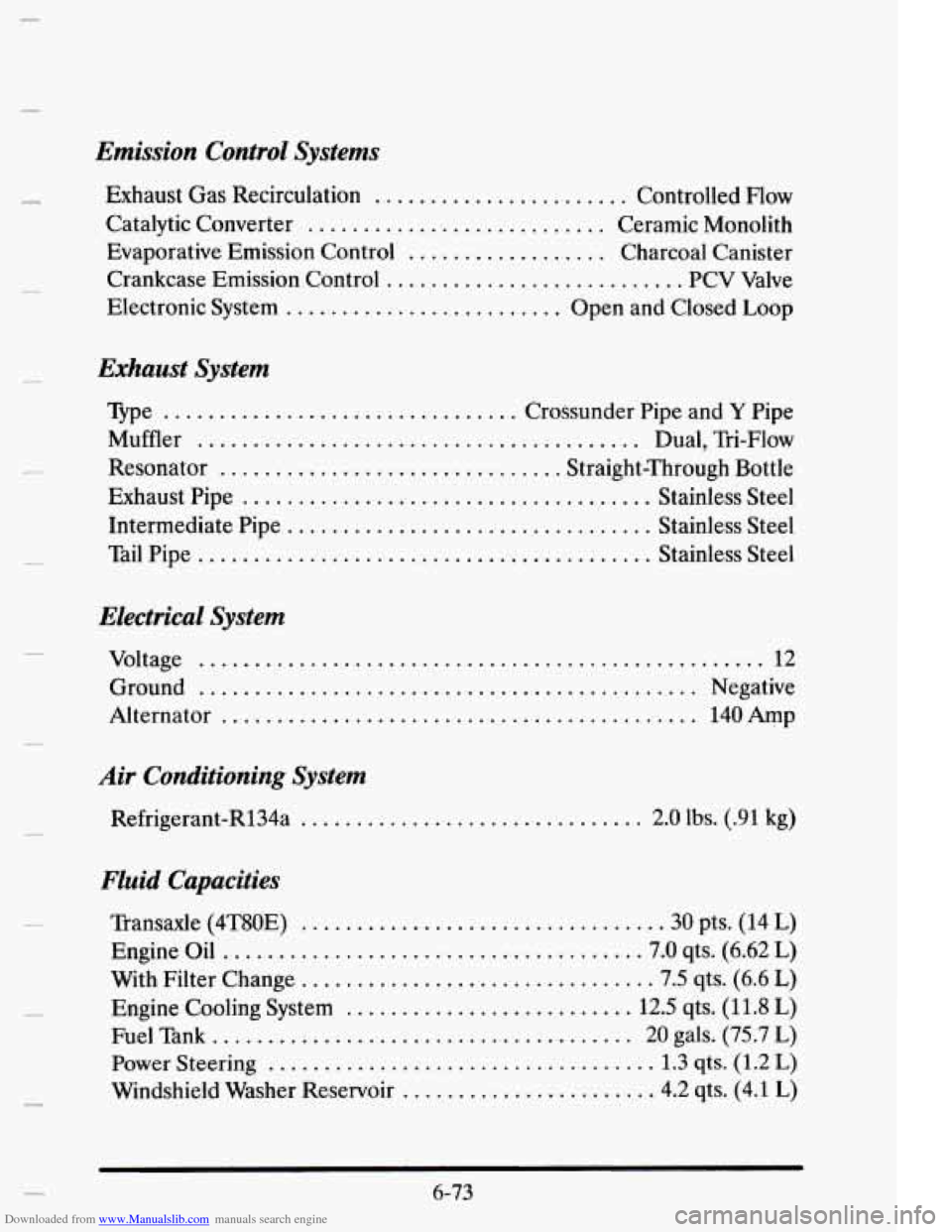
Downloaded from www.Manualslib.com manuals search engine Emission Control Systems
Exhaust Gas Recirculation ....................... Controlled Flow
Catalytic Converter
........................... Ceramic Monolith
Evaporative Emission Control
.................. Charcoal Canister
Crankcase Emission Control
........................... PCV Valve
Electronic System
......................... Open and Closed Loop
Exhaust System
Type ................................ Crossunder Pipe and Y Pipe
Muffler
........................................ Dual, Tri-Flow
Resonator
............................... Straight-Through Bottle
Exhaust Pipe
..................................... Stainless Steel
Intermediate Pipe
................................. Stainless Steel
Tail Pipe
......................................... Stainless Steel
Electrical System
Voltage ................................................... 12
Alternator
........................................... 140Amp
Ground
............................................. Negative
Air
Conditioning System
Refrigerant-R134a ............................... 2.0 lbs. (.91 kg)
Fluid Capacities
Transaxle (4T80E) ................................ .30 pts. (14 L)
Engine Oil ...................................... 7.0 qts. (6.62 L)
With Filter Change ................................ 7.5 qts. (6.6 L)
Engine Cooling System .......................... 12.5 qts. (1 1.8 L)
Fuel Tank ...................................... 20 gals. (75.7 L)
Power Steering ................................... 1.3 qts. (1.2 L)
Windshield Washer Reservoir ....................... 4.2 qts. (4.1 L)
6-73
Page 333 of 395
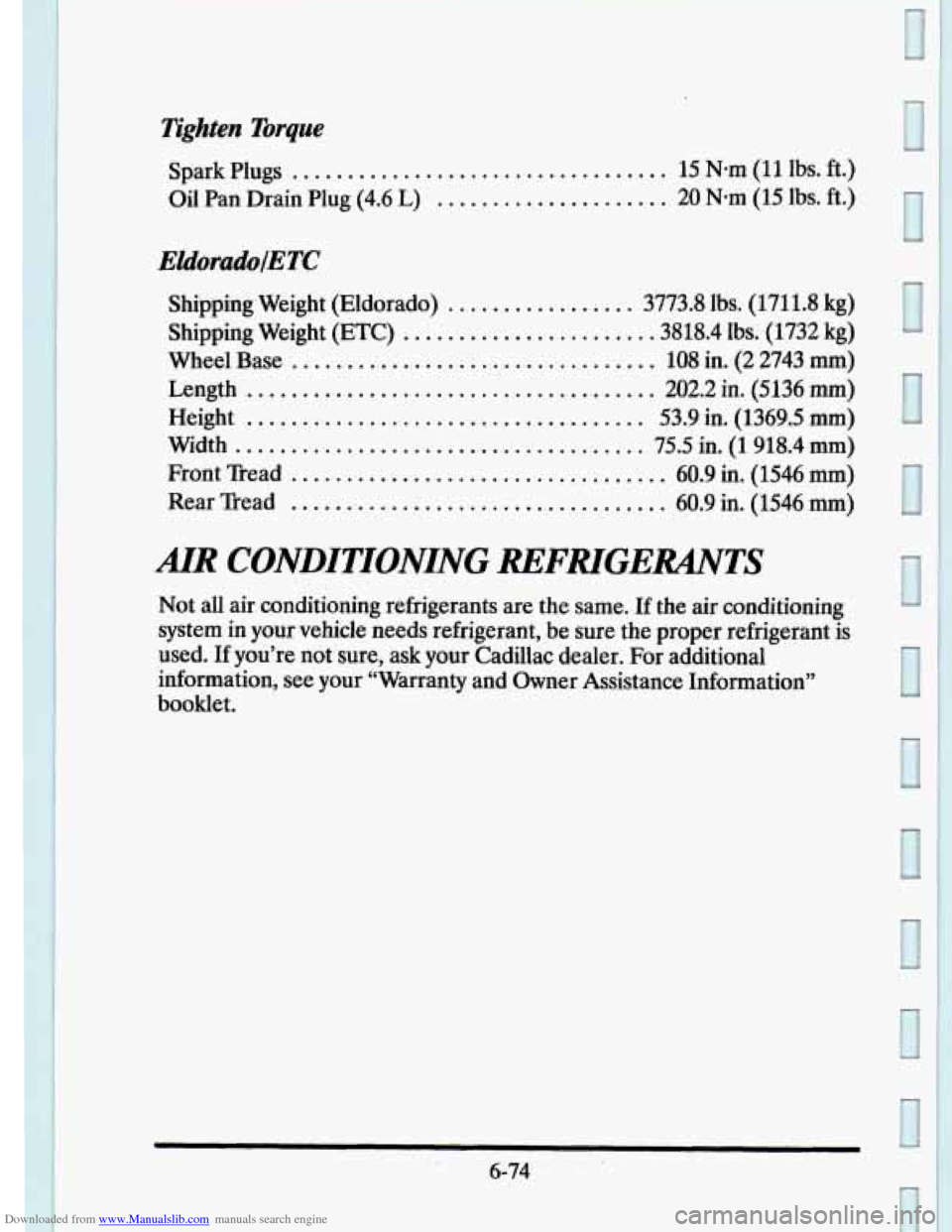
Downloaded from www.Manualslib.com manuals search engine Tighten Torque
Spark Plugs .................................. 15 N-m (11 lbs. ft.)
Oil Pan Drain Plug
(4.6 L) ..................... 20 N-m (15 lbs. ft.)
EldbrcadolETC
Shipping Weight (Eldorado) ................. 3773.8 lbs. (1711.8 kg)
Shipping Weight (ETC)
...................... .3818.4 lbs. (1732 kg)
Wheel Base
................................. 108 in. (2 2743 mm)
Length ..................................... 202.2 in. (5136 mm)
Height .................................... 53.9 in. (1369.5 mm)
Width ..................................... 75.5 in. (1 918.4 mm)
Front Tread .................................. 60’.9 in. (1546 mm)
Rear Tread .................................. 60.9 in. (1546 mm)
AIR CONDITIONING mFNGEWTS
Not all air conditioning refrigerants are the same. If the air conditioning
system in your vehicle needs refrigerant, be sure the proper refrigerant is
used.
If you’re not sure, ask your Cadillac dealer. For additional
information, see your “Warranty and Owner Assistance Informati\
on”
booklet.
6-74
I